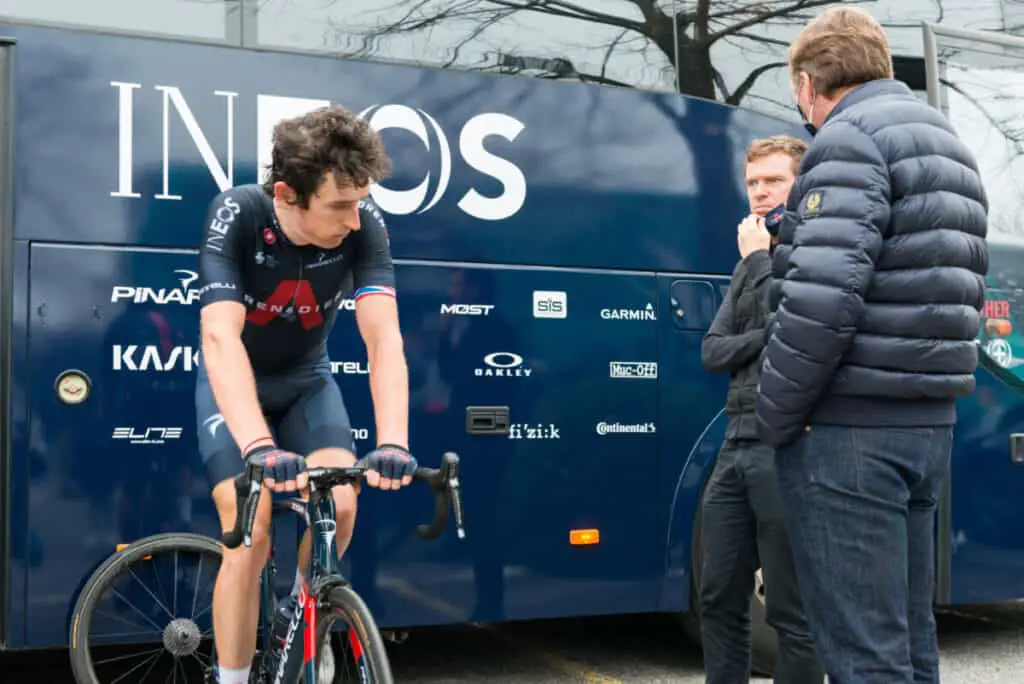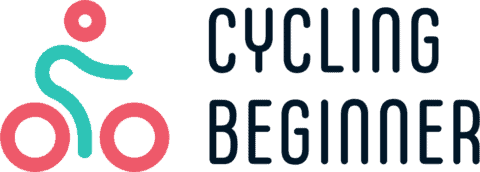If you ever watched any professional cycling race, you probably noticed that cyclists keep cycling on trainers after they’ve reached a finish. They’ve just ridden hundreds of miles, so why would they be tiring their legs even further?
Cycling after a race is part of active recovery, which helps cyclists to remove waste produced in their muscles during the race. The most common waste product is lactic acid. Around 15 minutes of cycling after a race is enough to remove most of it, making the cyclist’s legs fresher the next day.
Cycling is constantly evolving and modern research is helping cyclists get faster, stronger and more endurance. Stuff like active recovery was a groundbreaking ‘invention,’ but you would be surprised how long it took cyclists to figure it out.
Teams use the best turbo trainers on the market, which you can find by clicking here.
What advantages does cycling after the race have?
You can imagine that after a hard stage, the cyclists would prefer to get off their bikes and head straight to the team bus. But they can’t, they have to keep cycling, even though they have been doing it all day already.
They have a good reason for that. Putting in a few extra minutes after the stage helps them with the next-day performance and potentially saves them the rest of the race. They know that only fresh legs can win races, so they are willing to put in extra effort, even if they don’t feel like it most of the time.
Only fresh legs can win races!
During strenuous exercise, lactic acid is produced in the muscles. Although the body also uses it as fuel, too much of it can limit the muscle’s functionality, which is no longer able to contract at a normal rate. As a result, the cyclist can no longer push the pedals hard and their speed drops.
You probably sensed that lactic acid is something cyclists don’t want in their muscles. They try to remove it as fast as possible after the race, so the muscles can “breath” again.
Lactic acid is removed by pedaling after the race. The effort must not be too high, but not too low either. According to Keith Flory, former Director of Performance at American World Tour team Cannondale – Drapac, the best level to ride at is around 150 watts.
If the active recovery is too hard, it becomes counterproductive, as lactic acid is being produced instead of removed. On the other hand, if the watts that the rider is pushing are too low, the blood flow is slow, and not all of the “waste” gets removed.

If large amounts of lactic acid remain in the muscle, it does not recover and acidosis and potential cramping problems may occur earlier the next day.
One bad day can undo everything you’ve worked for in a race up to that point
The post-race cycling process is not just about removing lactic acid but also about preventing cramps. Cyclists’ tired legs are susceptible to severe cramps when the high effort is stopped quickly but are much less likely to cramp when the effort is slowly reduced.
Riding at low power for a few minutes after the stage also helps the body dissipate the heat more evenly.
You probably had the experience when you were engaged in some sort of physical activity and you were not as hot during the activity itself, but the moment you stopped, all the heat just rushed into your head and you started sweating like crazy. Continuing the activity at a low rate helps prevent just that.
And last but not least, cycling after the race also has a positive impact on mental recovery. Riders have time to calm down and reflect on the events that just happened. They can also focus their minds before stepping in front of the media.
Sometimes riders are so exhausted after a stage that they can’t even remember the color of the leader’s jersey or the name of their opponent. It might have been wise for Jonas Vingegaard to cool down a bit before he stepped in front of the microphone.
How long do cyclists cycle after a race?
Duration of cycling after the race differs from cyclist to cyclist and from stage type to stage type.
On average, cyclists do 10-15 minutes of a low-effort ride at about 150 watts. In that time, they remove most of the lactic acid from the muscles, prevent the cramps and slowly cool down. Top finishers then head off to media commitments and the rest goes to the team bus.
Not every cyclist goes on a trainer after the race to cool down. Some of them already do it in the race’s final miles.
On harder stages, normally those in the mountains, all cyclists don’t finish together. Many riders drop from the main group and form their own smaller groups. They then finish the stage in their own tempo, which is much lower than the leading group’s.
Because of the slower tempo, much less lactic acid is formed in the legs of riders in the back. The last miles of the stage also serve as an active recovery for them, so they don’t need to keep riding after the finish.
You can see similar stuff on the flat stages also. Sprinters are pushing to the very end, with the most intense effort just before the finish line.
They have to keep riding for a few minutes after the race, but much less than riders after the mountain stage. Their effort is much shorter, so less lactate is produced. For them, cycling after a stage is primarily about preventing cramps and dissipating body heat.
History of cycling after the race
Cycling is constantly evolving.
Riders used to drink alcohol during a race but later figured out that it might not be the best idea. Helmets were laughed at not that long ago but are mandatory now. So if you think that cooling down after a race is an old practice, think again. It actually became popular just a few years ago.
At the start of 2010’s British Team Sky, which was led by Bradley Wiggins back then, started emphasizing the importance of good active recovery. They were the first ones that made riding on trainers after the stage something common.

For almost a decade, they were the best team in the world and competition quickly started to analyze what they were doing differently. Riding on a trainer after the stage was the apparent difference, so everybody quickly followed the example.
Every team, from continental to World Tour level, nowadays regularly uses the post-stage cycling method for active recovery.
Of course, the cyclist did some type of active recovery prior to Sky’s ‘invention,’ but not in such a structured and scientific way. Most of the athletes just slowly rode to the team bus after the race and called that active recovery.
Recovery on the road vs. recovery on trainer
There isn’t much difference outcome-wise between active recovery on the road or a trainer. But cyclists still prefer to do it on a trainer, just because they can supervise those rides a bit better.
In the biggest races like the Tour de France, Giro d’Italia and La Vuelta, the distance from the finish to the team bus is usually quite long. This is especially true for mountain stages, where the buses are parked at the bottom of the climb and the riders have to descend from the top of the climb after the stage.
You can imagine that with all the spectators also descending, it can take quite a long time to get to the bottom of the climb and the time frame in which an active recovery still makes sense is slowly closing.
Nothing is left to chance in an era where the smallest of changes can be a difference between winning and losing.
Riding on a trainer eliminates this problem. A cyclist can be on a trainer three minutes after finishing the stage, making active recovery much more efficient.
Riders usually have trainers laid out in front of the team cars in the finish area. When they finish the race, they dismount their bikes, mechanics then mount the bike on a trainer and riders can start with active recovery.
Should I also keep cycling after my ride?
You don’t have to keep cycling after your ride. The effort of a recreational cyclist is much lower than that of a professional cyclist, so less lactate is produced. The last miles are also done at much lower effort due to traffic lights, junctions, etc., which counts as active recovery.
Our effort on a normal ride is much lower than the one of professional riders on a race. Of course, there is a difference between what a body of professional and amateur can sustain, but even after a high effort for an amateur, cycling after the ride is not necessary.
It’s common that cyclists live in a city or other populated areas, so even if you want to go all out till the very end, in most cases, that won’t be possible. There is a ton of traffic obstacles that will slow you down in the last miles, and your effort will drop significantly.
It is more important for you that you stretch after the ride. Do that immediately after you come home when the muscles are still warm.
It doesn’t have to be complicated, just a few simple stretches for your lower back, your legs, mainly thighs and calves, and a few for your arms, especially if you were riding on a rough surface.
Another great method of active recovery is foam rolling. After the ride, massage each stressed muscle with a roller. This will help keep your legs fresher the next day.
You will need a foam roller for that. It can be improvised with some object you find in your house, but I suggest investing in a real one. You can find them pretty cheap on Amazon. My pick would be 321 Strong Foam Roller.

